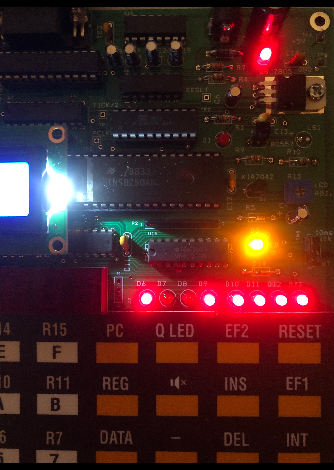Introduction to COSMAC 1802 Flasher Logic
In this section, we’ll write a simple program for a COSMAC 1802 Flasher. We’ll keep this as simple as possible, and use a couple delay loops. In this case, we’ll just use the Q output of the processor. The most important commands for this to work are the SEQ (Set Q) and REQ (Reset Q) instructions. I’m using the CDP1802 Microprocessor kit, but this should work with about any setup.
I’ve already installed the A18 assembler in Debian 11. Windows is another option though. The A18 assembler code comes with an EXE file for Windows. We’ll be using this assembler later in the post.
On the CDP1802 Microprocessor Kit, the yellow light connects to your Q output.

Set ORG and Registers
I like to start off any program by stating the starting memory location the code will reside at. For the CDP1802 Kit, this will be 8000H. Your set up may be different. Additionally, we will declare the aliases for our registers. This will make our programming a bit easier. This section is just for the assembler, and does not produce any direct output to the object code. Keep in mind, these 16 registers are the “Scratchpad” registers of the 1802 processor.
org 8000H
R0 EQU 0
R1 EQU 1
R2 EQU 2
R3 EQU 3
R4 EQU 4
R5 EQU 5
R6 EQU 6
R7 EQU 7
R8 EQU 8
R9 EQU 9
RA EQU 10
RB EQU 11
RC EQU 12
RD EQU 13
RE EQU 14
RF EQU 15Create Your Delay Loops
Without delay, or logic will run so fast that we probably wouldn’t see the light flash. We’ll create some delay loops that will add about a 1 second delay. You can adjust the number of times that each delay loop executes. In this case, the entire delay loop takes about 1 second to complete. To change the delays, just adjust the value in INIT0, INIT1, or INIT2.
INIT0: LDI 010H
DLY0: PLO RC
INIT1: LDI 010H
DLY1: PLO RD
INIT2: LDI 0DEH
DLY2: PLO RE
DEC RE
GLO RE
BNZ DLY2
DEC RD
GLO RD
BNZ DLY1
DEC RC
GLO RC
BNZ DLY0Set or Reset Q
At this point, we are ready to execute the SEQ and REQ instructions. This will set and reset the Q output on the processor. If you connect an LED to pin #4, be sure to add a resistor in series with the LED.
The BQ command checks to see if Q is set. If it is, then we jump to the OFF Label, which turns OFF the Q output with the REQ instruction. IF the Q Output was off, then the BQ instruction is false, and we execute the SEQ instruction to turn it on.
BQ OFF
ON: SEQ
BR INIT0
OFF: REQ
BR INIT0
ENDIn this case, we’ll save our work as “flasher.asm”. After that, you can run the assembler on your file to make sure there are no errors. You can either upload the hex file, or look at the list file. The flasher.lst file will list the OPCODES that you can enter manually.
Summary of the COSMAC 1802 Flasher
In short, we just declare some registers, and create a delay. If the output was ON, then we shut it off. Likewise, if the output was OFF during the previous scan, then we turn it on. This is a good program to get you started with programming your COSMAC 1802.
List File
Here is the output of the LIST file in case you wish to enter your program manually:
8000 f8 10 INIT0: LDI 010H
8002 ac DLY0: PLO RC
8003 f8 10 INIT1: LDI 010H
8005 ad DLY1: PLO RD
8006 f8 de INIT2: LDI 0DEH
8008 ae DLY2: PLO RE
8009 2e DEC RE
800a 8e GLO RE
800b 3a 08 BNZ DLY2
800d 2d DEC RD
800e 8d GLO RD
800f 3a 05 BNZ DLY1
8011 2c DEC RC
8012 8c GLO RC
8013 3a 02 BNZ DLY0
8015 31 1a BQ OFF
8017 7b ON: SEQ
8018 30 00 BR INIT0
801a 7a OFF: REQ
801b 30 00 BR INIT0
801d ENDFor more information, please visit the Vintage Computer Category Page!
— Ricky Bryce
